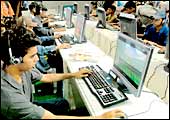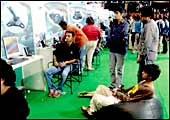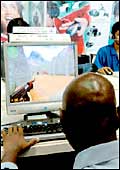 |
| Virtual life: Gamers try out a variety
of action, adventure, racing and strategy games at SKOAR 2006
(Bottom), whose theme was 2 Hot 2 Handle |
 |
BANGALORE
July 7-9, 2006
With
trembling, sweaty hands, I look around a dark corner, my Heckler
& Koch USP (universal self-loading pistol) .45 drawn, as I
warily eye what appears to be a deserted pathway between the building
I am standing in and the next, where I know there are half-a-dozen
terrorists waiting. The next 10 seconds are nerve-racking as I
cautiously nose ahead, keeping an eye out for the armed terrorists
I have to dispose off in the next few minutes. Just as I am beginning
to feel safe, a blinding burst of gunfire rakes our unit, and
we find ourselves cornered and outnumbered. All hell breaks loose
over the next 30 seconds, as the disoriented and cornered counter
terrorists (that's my team!) fire in all directions to try to
stave off the inevitable. As it turns out, our bravado is of little
help, and we are liquidated by a team of skilled marksmen in less
than a minute.
Fortunately for me, rather than deepest Iraq,
I am actually at SKOAR 2006, an annual gaming expo held this year
at Bangalore's Sree Kanteerava Indoor Stadium, where around 50,000
others jostle for an opportunity to try their hands at myriad
varieties of games. Blood and gore are actually lower down the
pecking order, with visitors preferring to queue up for a knuckle-whitening
ride of Need for Speed. What adds to the attraction for hardcore
gamers is the presence of computer chip, hard disk and peripheral
vendors, all looking to hook them with an array of top-end products.
"We have an entire range of gaming peripherals on display,
including mice, keyboards, steering wheels, gamepads and joysticks,"
says Moninder Jain, Director (South East Asia), Logitech.
While games have for long been restricted
to those who could buy consoles or game titles overseas, the arrival
first of the Sony PlayStation and more recently of Microsoft's
Xbox seems to have catalysed growth in the Indian market. At Rs
100 crore, the market for video games is said to be growing at
100 per cent a year in India. The Sony PS stall, run by Milestone
Interactive Software, the India distributor for the handheld,
is swarming with gamers trying not only the PS, but the very nifty
PSP (PlayStation Portable) too. "Consoles are more fun than
playing on a computer, since you can plug it into a large screen
TV and enjoy better game play," says Gaurav Aggarwal, 15,
who is set to junk his ps2 later this year when the newer ps3
hits Indian store shelves.
Unlike global markets, Sony has something
of an unchallenged position in India, with the Nintendo DS hard
to come by and Microsoft launching its gaming consoles in India
nearly a year after its global launch. Despite this headstart,
Jayant Sharma, Chairman and CEO, Milestone Interactive Software,
says Sony has a long way to go, since "90 per cent of all
console sales in India are in the grey market, and we are just
beginning to scratch the surface."
 |
| Testing ground: Visitors check out games
and equipment at the Logitech stall (Bottom) and BenQ's latest
range of flat LCD monitors |
|
|
The infancy of the Indian market has, however,
not stopped several Indian vendors from also making a sizeable
investment in the market. Sify, the online portal, for example,
has created A3, perhaps India's first massively multiplayer online
role playing game (MMORPG) that sees gamers collaborate across
the internet on their missions. While this genre of gaming has
achieved near-cult status in countries such as South Korea, where
broadband is pervasive, it's also beginning to grow in India,
with titles such as Ragnorak and more recently A3. "There's
going to be a lot more action around the MMORPG market in India,
since the number of broadband users has increased from 100,000
last year to over one million today," says Rajesh Rao, CEO,
Dhruva Interactive, a Bangalore-based games developer for the
$30-billion (Rs 1,41,000-crore) global industry, besides the Indian
market.
With 100 million-plus mobile subscribers
now in India, Rao also reckons that mobile games would be an easy
and profitable way of growing the game-playing population. According
to some industry estimates, the Indian mobile gaming could grow
to $100 million (Rs 470 crore) in the next four to five years,
given the rapid growth in cellular user base and increasing preference
for high-end handsets. "Around a quarter of the user base
has Java-enabled phones, which are required for gaming,"
says Rao.
Coming back to the expo, the second edition
of SKOAR did leave some visitors spellbound, but there were many
visitors who left the venue unimpressed. "The games at the
venue were at least two-three years old and the queues were far
too long," says software engineer Vishnu S. Iyengar, who
adds that aside from the Sony PS stall, there needed to be a wider
selection of gaming gear. "There have been at least three
new consoles that they could have demoed at this event instead
of just having the dated PS," he argues. Organisers, take
note.
|








